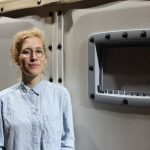There are millions of people living in refugee camps around the world. The social enterprise Better Shelter tries to make a difference by designing shelters to refugees living in camps. The Head Of Communication Märta Terne visited Habitare Collection at the Habitare Fair. Habitare Collection is on display at the Habitare Fair this weekend.
“Through smart design, innovation and modern technology we strive to create a safer, more dignified home away from home for the millions of persons that have been forced to flee their homes. The Better Shelter is a weatherproof temporary shelter that offers a more dignified home for displaced families as well as a cost-effective solution for humanitarian organizations.” – Better Shelter
What does design mean in the case of Better Shelter?
Design means everything. Our product may not be the prettiest, but it is highly functional. It’s important that the final product works like it is meant to work.
We made many prototypes before Better Shelter was taken into real camps. As a part of the designing process we received important advice from Ikea and the Ikea Foundation about the flat packaging and logistics. We also worked tightly with the UNCHR, which provided requirements that informed much of the design process.
Better Shelter must be easy to put together and to easy modify as well. The design must be as simple as possible so if something gets broken or loosens people can fix it themselves.
Were you aiming for a minimalistic design?
Our designers wanted to create something functional, but also something that would sit well in different cultures. We stripped down everything that was not necessary and what was left was a very basic frame of a house. It kind of looks like something a child would do, when asked to draw a house, but really it is a result of careful planning, designing and modifying.
The Better Shelter has been manufactured since 2015. What have you learned since then?
By working closely with our partners, the Ikea Foundation and UNCHR and gathering feedback from the people who live in our shelters, we are improving our solutions continually. It is important that the product answers to the specific basic needs that people in the refugee camps really have.
The product is not “finished”- it is evolving all the time. As we go forward, we are learning more about the conditions in different countries and the ways people are using the shelters. Better Shelters can be used as a home, but also as temporary clinics and class rooms.
We will be looking into add-on products that could make the shelter even more useful for other applications, as well as improving the modularity even more and working on the possibility to dress the frame with local materials.
What is the role of design in solving the problems of the world?
Needless to say, Better Shelter is not trying to solve the whole refugee crisis, it’s not even trying ty fix all problems in the refugee camps. But this is one step in the right direction as everyone needs a safe and homely place to live. Better Shelter has a solar panel light and a lock on the door. That may not sound like a lot, but it is a significant improvement for many people.
Märta Terne, Head Of Marketing and Communication/Better Shelter
Better Shelter is a Swedish humanitarian innovation project and a social enterprise owned by the philanthropic Housing for All Foundation. We are driven by a mission to improve the lives of persons displaced by armed conflicts and natural disasters.
Since 2015, Better Shelters have been shipped to emergency relief programs and refugee camps Ethiopia, Greece, Iraq, Macedonia, Niger and Nepal. The Better Shelter was developed through ground-breaking collaboration and a strong partnership with UNHCR and the IKEA Foundation.

